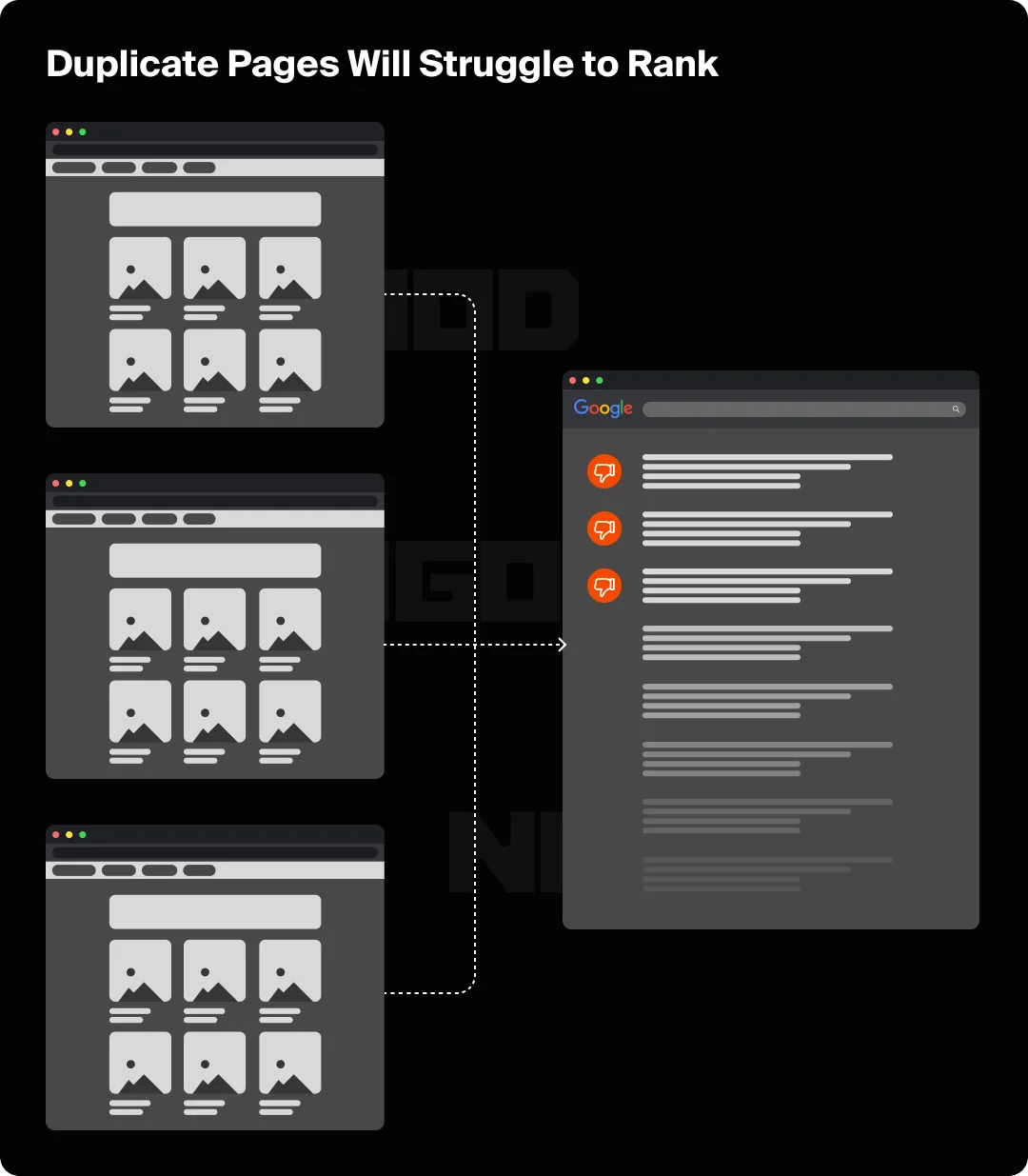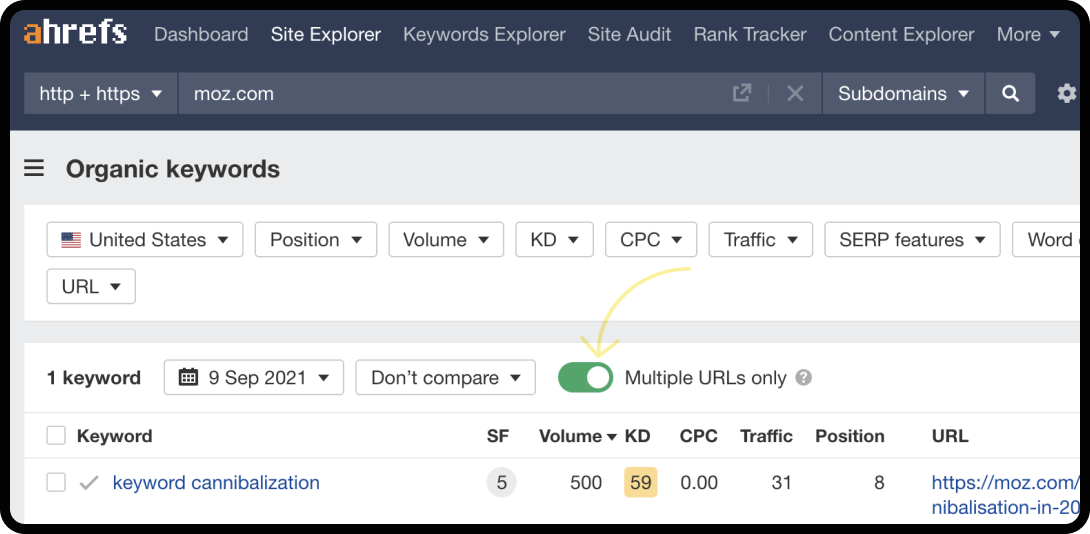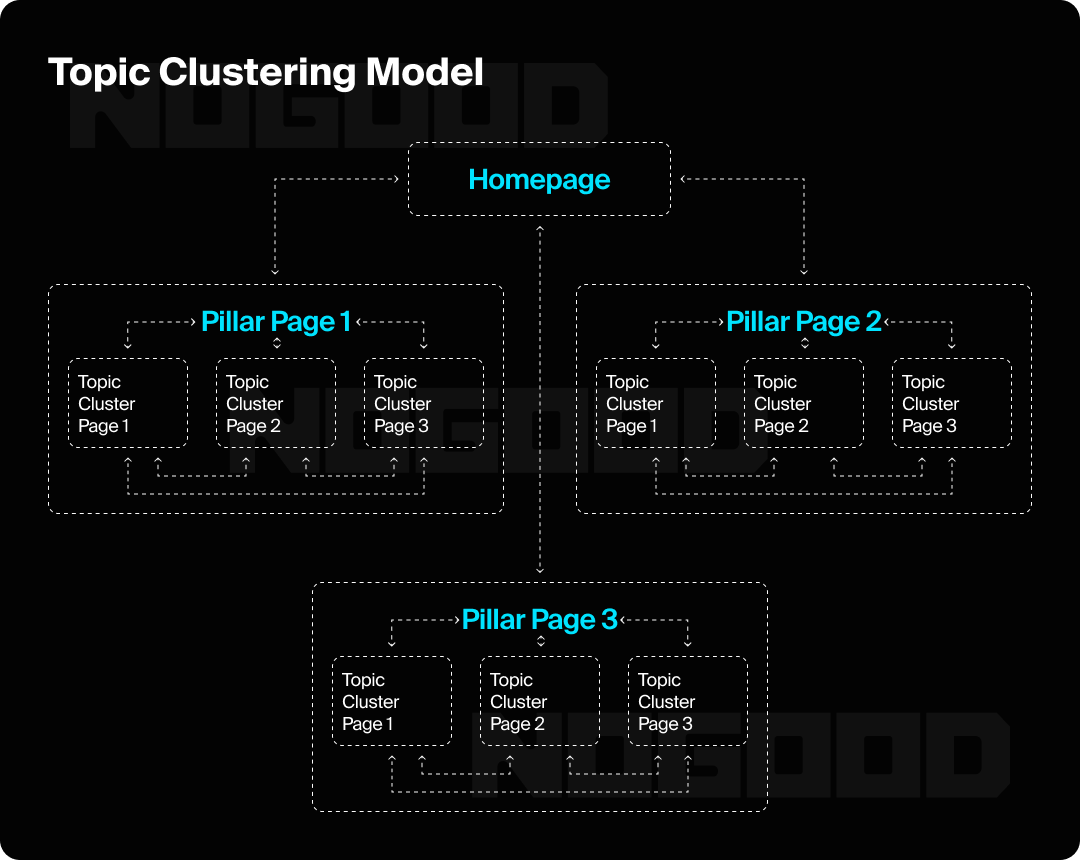Implementing an effective SEO strategy can be a difficult task to navigate. You’ve poured resources into creating great content, found your ideal keywords, and gained high-quality backlinks, yet your search rankings fluctuate and organic traffic remains stagnant.
But what if your biggest competitor isn’t another website? What if it’s your own?
The hidden culprit is content cannibalization: a self-inflicted SEO wound where your own webpages compete against each other for the same search queries.
This guide will serve as your essential roadmap: we’ll show you exactly how to diagnose content cannibalization, understand its impact, and implement an actionable strategy to fix it.
What Is Content Cannibalization?
Content cannibalization occurs when two or more pages on the same website rank for, and effectively compete with one another over, the same search query. This internal competition can hurt a site’s overall organic performance, because instead of your website presenting a single authoritative page on a given topic, it offers multiple pages that are fighting for the top spot in the search engines result page (SERP).
So, why does this happen? The issue often stems from a disorganized content strategy. Without a well-defined plan, content teams may inadvertently create multiple articles that cover similar topics and target the same long-tail or short-tail keywords. This can also happen when a site grows too quickly without a formal keyword mapping process in place. In essence, it’s the result of creating too much content without a system to prevent topic and keyword overlap.

What Is an Example of Content Cannibalization?
A common example of content cannibalization is a blog that focuses on SEO. Imagine the blog has two separate articles: one titled “Top 10 SEO Tips for Beginners” and the other titled “A Beginner’s Guide to SEO.”
Both of these posts are targeting the same search intent: to provide introductory SEO information to people new to the topic. They likely use similar, if not identical, long-tail keywords such as “beginner SEO tips,” “beginner SEO strategy,” and “how to start with SEO.”
Instead of working together, these two pages are essentially competing for the same spot in Google’s search results. This situation creates several problems:
- Confused Search Engines: From Google’s perspective, the blog has two similar pages on the same website, making it difficult to decide which one is the most relevant or authoritative.
- Ranking Fluctuations: This confusion often leads to ranking fluctuations, where Google might show one page one day and the other the next, preventing either from achieving its full ranking potential.
- Wasted Authority: The internal competition not only hurts the visibility of both pages, but also wastes your website’s link equity and confuses users, who may land on a page that isn’t the best resource for their query.
Why Is Content Cannibalization Bad for SEO?
While some of the negative impacts of content cannibalization were previously mentioned, let’s take a deeper dive into why it’s detrimental to your SEO efforts.
Diminished Authority
Instead of a single page accumulating all the link equity and authority for a specific keyword, that “juice” is split across several weaker pages. This dilutes your site’s overall topical authority in the eyes of a search engine, preventing any one page from achieving its maximum ranking potential.
Wasted Crawl Budget
For search engines like Google, every website has a limited crawl budget (the number of pages a search bot will crawl and index on your site during a single visit). When multiple pages are competing, Google wastes valuable time and resources crawling and indexing redundant content. For large websites with thousands of pages, this can mean that newer, more important content is indexed much more slowly, if at all.
Lower Organic Traffic
This is perhaps the most direct negative impact. When traffic is split between competing pages, neither page receives the full benefit of its potential organic visibility. The same goes for link equity from internal links and external backlinks. This fragmentation leads to lower overall click-through rates and less organic traffic to your site as a whole.
Poorer User Experience
Above all else, cannibalization hurts the user experience (UX). A user’s search intent may not be perfectly matched by one of your competing pages, especially if it’s not the most comprehensive or best-written version. This can lead to fewer engaged sessions, as users quickly leave to find a better resource. A poor user experience also signals to Google that your content isn’t helpful, which can further damage your rankings over time.
How To Identify & Fix Content Cannibalization
Fixing content cannibalization is a strategic process that starts with a thorough content audit to pinpoint competing URLs and decide on the best course of action. Here’s a practical, step-by-step guide to help you get started.
Step 1: Perform a Content Audit & Identify Competing Pages
The first step is to find out exactly which of your pages is causing the problem. After all, you can’t fix what you can’t see. Here’s how we recommend doing it:
- Leverage Your SEO Tools: The most efficient way to identify competing pages is by using professional SEO tools like Ahrefs or Semrush. Tools like Ahrefs have features that can quickly identify these “keyword cannibalization” issues for you. No matter which tool you’re using, look for instances where multiple URLs from your domain appear for a single target keyword.

- Look for the Telltale Signs: A clear sign of cannibalization is seeing two or more of your URLs consistently ranking in a similar range for the same keyword. This is a giveaway that Google is unsure which page to prioritize for that specific search intent. You might also notice significant and frequent ranking fluctuations for the keyword, as Google repeatedly swaps out the ranking URL.
Step 2: Analyze the Competing Pages
Once you’ve identified competing URLs, you need to analyze them to determine the best solution. Don’t rush to delete content without performing this analysis.
- Evaluate Content Quality: Open and carefully examine each page’s content, depth, and overall quality. Ask yourself: which page provides a more comprehensive, up-to-date, and authoritative answer to the user’s search intent?
- A content audit is not just about keywords; it’s about evaluating the value each page provides.
- Check Performance Metrics: Use your analytics and SEO tools to compare the performance of the competing pages. Look at key metrics like organic traffic, inbound internal links, external backlinks, and historical keyword rankings for each page. This data will provide insights into which page is a stronger candidate to be the primary page.
Step 3: Fix Content Cannibalization
After your audit, you can apply one (or more) of the following strategic solutions to resolve the issue and consolidate your website’s authority.
Consolidate & Merge (The Best Option)
Often, the most effective fix involves combining the best elements from the competing pages into a comprehensive, authoritative long-form page. This new page transforms into the definitive resource for that topic on your site.
Once it’s live, implement a 301 redirect from the URLs of the old pages to the new one. This ensures that any existing link equity and authority is passed on, strengthening your new pillar content.
Use Canonical Tags (For Duplicate Content)
A canonical tag isn’t a fix for true cannibalization, but it can help you manage nearly identical pages that are both necessary for your site’s structure. For example, if you use faceted navigation, resulting in different URLs for the same product based on color or size, a canonical tag tells Google which URL is the “master” or preferred version. This prevents Google from wasting its crawl budget and ensures your chosen page ranks.

Content Pruning
For outdated content that offers little value and cannot be merged, content pruning is a viable option. Deleting this content and implementing a 301 redirect to a relevant, high-quality page helps to clean up your site and focus its authority on your best-performing content. This practice can improve your overall site health and help search engines better understand your content hierarchy.
Strategic Internal Linking
If your site has a clear content hierarchy (e.g., a main pillar page supported by several cluster pages), you can use strategic internal linking to guide search engines. Ensure that the supporting pages link back to the “pillar page” using relevant anchor text. This reinforces which page you want to rank for the primary keyword and helps consolidate authority.

Update & Optimize
In some cases, you don’t have to delete or merge a page. You can update one of the competing pages to target a slightly different, more specific long-tail keyword. This requires re-evaluating your keyword research and the page’s on-page SEO.
Don’t forget to also update the title tag and meta description to align with the new, narrower search intent, thereby eliminating internal competition.
Strategies to Fix Content Cannibalization
| Solution | What Is It | When to Use It |
| Consolidate & Merge | Combining the best elements of multiple pages into one comprehensive, high-authority page. | When two or more pages are very similar and can be merged into a single resource. This is often the best option. |
| Use Canonical Tags | Placing a canonical tag on a page to tell search engines which URL is the “master” version. | When you have necessary duplicate or near-duplicate content (e.g., product pages that only differ by color or size). |
| Content Pruning | Deleting outdated, low-value content that can’t be merged or updated. | When a page is old, performs poorly, and doesn’t contribute value to the site. |
| Strategic Internal Linking | Using internal links from supporting pages to point to the main, authoritative page. | When you have a clear content hierarchy (e.g., a pillar page supported by cluster pages). |
| Update & Optimize | Reworking a competing page to target a different, more specific keyword. | When a page has potential but its content overlaps with another page, and you want to keep both. |
Proactive SEO Is Key
Let’s face it: for SEO, few things are more frustrating than a problem you’ve accidentally created yourself.
You now know that the damage, from lost traffic to diluted authority, is real, but there’s good news: this problem is completely fixable, and even better, it’s preventable.
By getting into the habit of auditing your content regularly, you can turn your website from a jumble of competing pages into a unified force. The content cannibalization fixes we’ve gone over aren’t just one-time hot fixes; they’re key parts of a long-term SEO strategy.
Content Cannibalization FAQs
What is an example of cannibalization?
Imagine a company’s blog has two separate posts:
- “Top 10 SEO Tips for Beginners”
- “SEO Tips Every Beginner Should Know”
Even if the titles are slightly different, both posts are trying to rank for keywords like “SEO tips for beginners” and “how to start with SEO.” This creates a problem because the pages are competing with each other instead of a competitor’s site. As a result, Google gets confused about which page is the authoritative source, and both pages end up underperforming in search rankings.
What is cannibalism in SEO?
Be very careful! You’d use the word “cannibalism” if you were being chased in a jungle by people who want to eat you. In SEO, the correct term for when your blog has two or more articles that are very similar and target the same search intent is cannibalization. Don’t get these terms mixed up in a meeting, otherwise everyone’s gonna look at you funny.
How to fix cannibalization in SEO?
Fixing content cannibalization requires a strategic approach. Here are the most common and effective solutions:
- Consolidate & Merge: The best solution is often to combine the best parts of the competing pages into one comprehensive page. You would then use a 301 redirect to send traffic and link equity from the old URLs to the new one.
- Use Canonical Tags: If you have pages with nearly identical content (like product pages that only differ by color), you can use a canonical tag to tell Google which one is the master or preferred version.
- Update & Optimize: Instead of deleting a page, you can optimize it to target a slightly different, more specific long-tail keyword, thereby eliminating the competition.
- Content Pruning: For old, low-quality pages that aren’t worth merging or updating, you can simply delete them and implement a 301 redirect to a relevant page on your site.
Is keyword cannibalization good or bad?
Keyword cannibalization is bad for your SEO. While some people might think having multiple pages rank is a good thing, it actually causes more harm than good. Cannibalization leads to:
- Wasted Authority: Instead of one authoritative page, you have two or more weaker ones competing, which dilutes your website’s overall authority.
- Ranking Instability: It can cause ranking fluctuations, as search engines struggle to decide which page to prioritize.
- Lower Traffic: Your organic traffic is split between the competing pages, preventing any single page from reaching its full potential.






